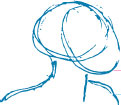Rather than tackling a head drawing with its down-the-road-to-destruction details, try approaching it by some simple basic shapes. Talk to yourself (it helps to talk your way through a drawing because ordinarily we don’t carry very many fancy descriptive terms in our everyday vocabulary), and if we follow just the simple things we can describe, we’ll have less trouble. For instance, for the animator a few words like “structure,” “angle,” “squash,” and “stretch” will carry us pretty far into any drawing. Okay (this is still you talking to yourself) the head structure is basically this shape:

This particular head is tilted 3/4 to the left and is facing 3/4 to the front, and since this is a 3/4 view of the upper oval — it will now be half way between an oval and a circle:
Not this,

or this,

but this,


I see because the head is tilted to the left (observers left) that the left side of the neck is going to be squashed while the right side will be stretched:

Now I need some shoulders to stabilize what I’ve drawn. Because I know that the neck merges into the spine in the back and into the chest in the front (I will hook up my mental computer for a side view — ah, there it is).

I will now add the shoulders with that in mind.

making sure to connect the neck gracefully to the shoulder on the left, and connecting the other shoulder with a nice strong angle to give it a third dimensional look, because I know that this
![]()
puts the neck in front of the shoulder better than this,
![]()
or this,
![]()
or this,
![]()
or this,
![]()
or this.
![]()
The hair is quite a dominant feature on this person and since the head is tilted that way I see that the hair reacts somewhat like the neck, so I’ll draw a squash on the left side and a stretch on the other:

I want to make sure I’m being clear (and simple) about the hair, and though on the model it sort of goes this way and that — I must be logical. So I will simply drape the hair over the shoulder on the squash side and let the hair stretch down past the right shoulder, and oh yes, making sure I use that principle of perspective (one object in front of another to create depth) by getting a good angle on the meeting place of the hair and shoulder.

rather than this,

or this,

or this.

Also, regardless of how wind-blown the hair is or what the styling is, basically the top of the head is rather flat, the back of the head is rather like a skull, and the forehead does a rather sharp turn then gently curves down to the chin, which is rather sharp, but sometimes a little bit flat across the bottom and the jaw line is rather prominent as it curves back toward the ear:

So now I have just used up my four-word drawing “starter vocabulary” and so far it feels pretty solid. Now, I don’t know about you (you’re still talking to yourself) but I think this is a good start, and I think it might be time to add a nose and a couple of eyes, but of course not until I’ve gotten some simple shapes in mind — something like what I’ve done so far:

I think it’s pretty safe, if not essential, to think of the head as basically two oval shapes. Those shapes automatically suggest a kind of flat plane on the top of the head, plus that bump at the back of the head; a flatness for the face and a chin. It even helps locate a place for the ear:

From the front, a circle for the top portion of the head and the oval for the facial area again automatically suggest a temple, the narrow facial area, and a chin:

If these are thought of as the basic head, then from there one can deviate for the cartoon or the caricature look. You may want to go as far as to suggest the head takes on one of these shapes

as some of the characters of our former pictures have done. But hidden in all the myriad poses and gestures of the various characters are those basic shapes plus the creative use of those four basic words: structure, angle, squash, and stretch.
Next are a few of the characters from Disney features and shorts. They are all built on some basic head shape or shapes, after which the details such as their features are added. The shapes are flexible, that is “animateable,” but never so flexible as to take on the shape or personality of some other character. The skull is usually pretty solid, while the rest of the head parts do the squashing and stretching. It’s pretty hard to go wrong if you handle the basics correctly. It’s the same in any activity — the basics have to be learned first, then, and only then, may the details be added to complete the creative act.

